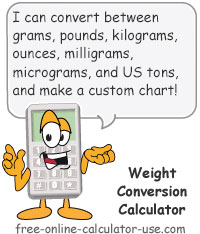IMPORTANT: Numeric entry fields must not contain dollar signs, percent signs, commas, spaces, etc. (only digits 0-9 and decimal points are allowed).
Click the Terms tab above for a more detailed description of each entry.
Step #1:
Select the type of conversion you would like to have calculated.
Step #2:
Enter the units you are converting from. Or, if you want to create a printable conversion chart, skip to the bottom of the calculator and enter the starting and ending units, then click the "Create Conversion Chart" button.
Step #3:
Click the "Convert Weight Units" button, which will display the result of the conversion and generate a step-by-step explanation showing how the calculator arrived at the result.


Follow me on any of the social media sites below and be among the first to get a sneak peek at the newest and coolest calculators that are being added or updated each month.